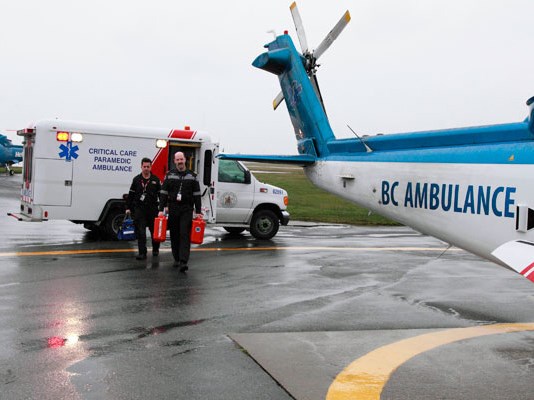Night air ambulance service to Texada/Gillies Bay Airport continues to be suspended, but airport authorities are working on a plan for Transport Canada approval to allow night landings.
As several major BC hospitals deal with disrupted night air ambulances, Texada residents have been without the service since January.
“It has a lot of people concerned,” said Texada Health Services Society president Rob McWilliam. “Obviously, you never plan on being seriously ill, but if you are it’s nice to know there’s a system to provide support. Right now, that’s inadequate.”
BC Emergency Health Services (BCEHS) spokesperson Preet Grewal said air ambulance operator Helijet International recently notified BCEHS that Gillies Bay airport is not certified by Transport Canada for night operations.
Due to Texada’s proximity to the Lower Mainland, the fixed-wing air ambulance would not be used, said Grewal.
According to Gillies Bay airport manager Russell Storry, Powell River Regional District has brought in Powell River aviation consultant Ken Glaze from VertFlight International to help develop operating procedures for night landings that are Transport Canada certified.
“Work has progressed and we’re close to submitting to Transport Canada,” said Storry.
McWilliam said with shorter days coming in fall and winter, Texada residents are worried the problem is far from being resolved.
A review of health emergencies earlier in the summer showed four instances where air-ambulance service was needed at night, but other measures had to be taken, such as having BC Ferries make an emergency sailing to Westview, or calling Canadian Coast Guard for help, said McWilliam.
“That adds a whole lot of extra time,” he said. “When someone is critical enough to need medical evacuation out, time is a factor.”
According to Grewal, since 2014 the air ambulance service has “cared for and transported six patients from Texada.”
Gillies Bay airport has had procedures in place for night air-ambulance service since 2010, said Storry, when Helijet prepared a report recommending the use of the airport for night service using temporarily deployed landing lights, also known as turbo flares, and temporary windsock lighting. Since then, Gillies Bay Volunteer Fire Department has been facilitating night landings by deploying the temporary landing and windsock lights, he added.
But McWilliam said the community feels like it is caught in the middle of a bureaucratic fight between Helijet and Transport Canada.
“Where’s the practicality in all of this?” he said. “We have a windsock, flood lights and turbo flares we put out on the runway in the pattern Helijet requested. That’s not good enough?”
Transport Canada identified that similar to Tofino-Long Beach Airport, Texada/
Gillies Bay is not certified by the federal transportation authority for night helicopter landings. Transportation board investigators identified problems with night air-ambulance service on Texada after looking into a November 2015 incident at Tofino where pilots of an air ambulance helicopter flight temporarily lost control of the aircraft and nearly crashed. Transport Canada also found night visibility problems with three Sikorsky S-76C helicopters Helijet uses as provincial air ambulances.
While the regional district looks at having Gillies Bay certified by the federal transportation authority, BCEHS said if Helijet is unable to provide service to hospital helipads, including Sechelt, Comox and Nanaimo, among other major locations in Metro Vancouver, the provincial body may look at revoking the company’s eight-year, $104-million contract, which is due to expire in 2019.
Helijet vice-president Rick Hill recently told media that the company has an 18-year history of safe medical evacuation operation and, if needed, it would look at replacing the aircraft.
Storry said if Transport Canada does not approve the new operating procedures that include the use of more turbo flares, the Texada airport may be forced to construct a permanent helipad, which could cost up to $100,000.



